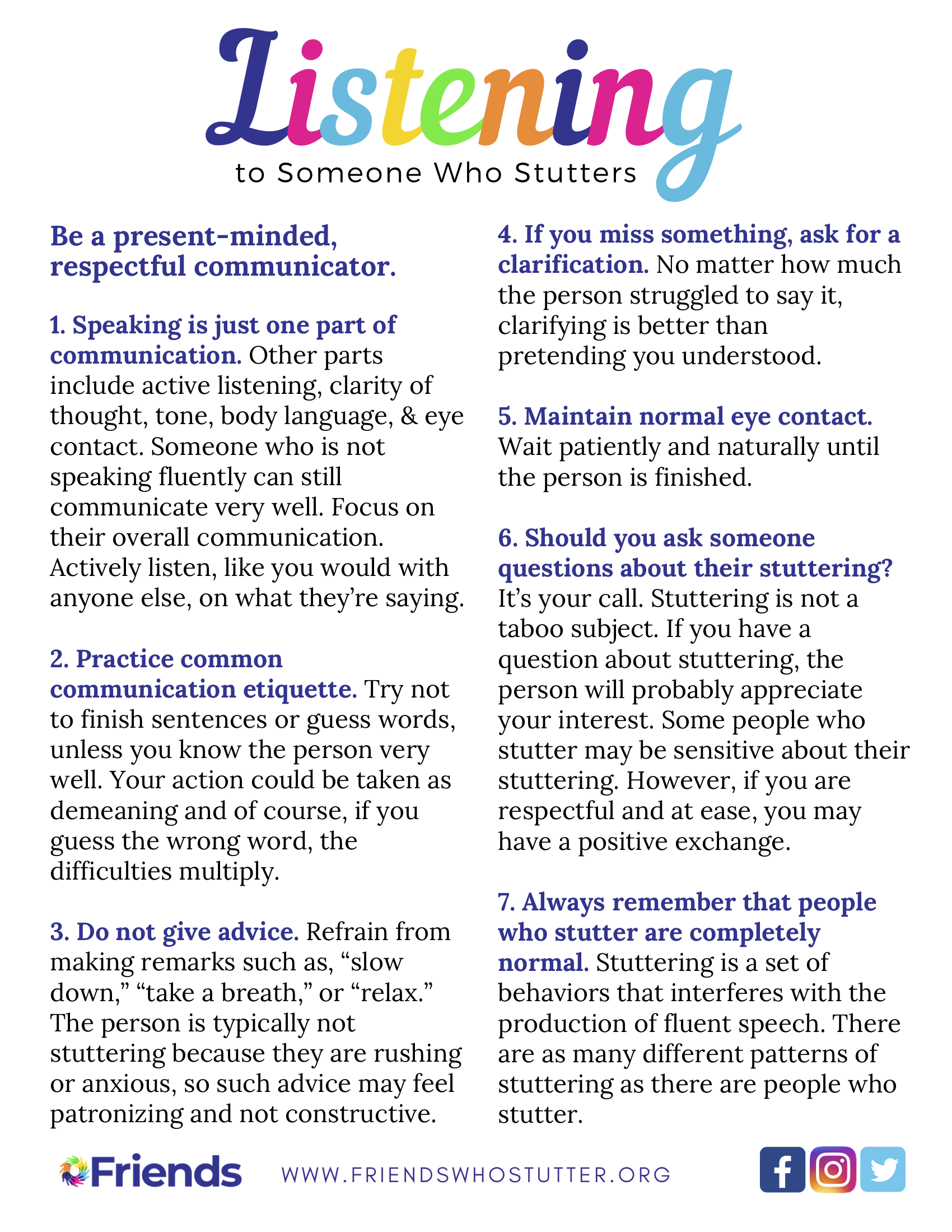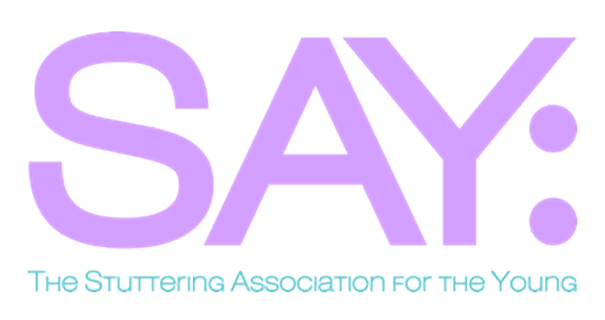Stuttering 101
Over 80 million people across the world stutter.
What is stuttering?
Stuttering is a complex communication disorder that affects approximately 1% of the population (over 80 million people globally) and 3 million Americans. Many children go through a period of stuttering but then outgrow it, so approximately 5% of children stutter at some point in their lives.
Stuttering is a variable disorder that can be confusing and potentially frustrating at times. Stuttering frequency can change from word to word, sentence to sentence, hour to hour, month to month, or even year to year. Sometimes, environmental factors can effect the variability in fluency, but other times, spontaneous fluency appears to be random. Because of this variability, in addition to environmental factors and the challenges of therapy, progress is not always linear.
- Affective: The way one feels about stuttering, such as: feeling ashamed, embarrassed, anxious, etc.
- Behavioral: The observable characteristics, such as repetitions (c-c-car), prolongations (mmmine), blocks (—-book), physical struggle, avoidance behaviors, etc.
- Cognitive: The way one thinks about stuttering and themselves, such as: thinking people don’t like them, thinking they are stupid, thinking they are less of a person, etc.
As described in this definition, stuttering is more than just the way someone speaks. Stuttering can affect every aspect of a person’s life. Often, because of the affective, behavioral, and cognitive reactions, stuttering can largely impact a person’s quality of life. While complete fluency is not always attainable, with support and the help of FRIENDS, stuttering does not need to negatively impact any child or family.
What Causes Stuttering?
No single cause of stuttering has been discovered, but research suggests that numerous factors contribute to the disorder. The main aspects thought to collectively cause stuttering include:
- Genetics
- Neurological
- Components of Language Development
- Motoric Ability
- Child’s Temperament
While people who stutter may experience embarrassment, anxiety, stress, and fear regarding speaking, stuttering is NOT an emotional or psychological disorder.
Stuttering Facts
Approximately 1% of the population stutters (over 80 million) and about 3 million Americans stutter.
- Stuttering is generally not caused by psychological or physical trauma.
- Stuttering is not related to intelligence
- Approximately 4 males stutter to every 1 female
- Many preschoolers who show early signs of stuttering will outgrow it. However, we cannot predict who will recover spontaneously. Speech therapy at an early age can increase the likelihood that the child will recover.
- There are no cures for stuttering. Speech therapy can help a person communicate effectively and make long-term changes over time.
- Approximately 5% of all children go through a period of stuttering that lasts six months or more. Three-quarters of those will recover by late childhood.
- Talking with a child about stuttering does not cause stuttering to become more severe or persistent.
- Stress, anxiety, and nerves can increase a child’s stuttering, but they are not the cause of stuttering.
- Stuttering exists in all languages and all parts of the world.
My Stuttering
– Name
Approximately 1% of the population stutters (over 80 million) and about 3 million Americans stutter.
What to Do When Talking to Someone Who Stutters?
Be a present-minded, respectful communicator.
- Speaking is just one part of communication – other parts include active listening, clarity of thought, tone, body language, eye contact, etc. Someone who is not speaking fluently can still communicate very well. Focus on their overall communication; actively listen, like you would with anyone else, on what they’re saying.
- If you miss something, ask for a clarification. No matter how much the person struggled to say it, clarifying is better than pretending you understood.
- Practice common communication etiquette: try not to finish sentences or guess words, unless you know the person very well. Your action could be taken as demeaning and of course, if you guess the wrong word, the difficulties multiply.
- Don’t give advice. Refrain from making remarks like: “slow down,” “take a breath,” or “relax.” The person is typically not stuttering because they are rushing or anxious, so such advice could feel patronizing and is not constructive.
- Maintain normal eye contact – wait patiently and naturally until the person is finished.
- Should you ask someone questions about their stuttering? It’s your call. Stuttering should not be, and is not, a taboo subject. If you sincerely have a question about stuttering, the person will probably appreciate your interest. Some people who stutter may be sensitive about their stuttering. However, if you are respectful and at ease – like you are with anyone else – you should be fine.
- People who stutter are completely normal. Stuttering is a set of behaviors that interferes with the production of fluent speech. There are as many different patterns of stuttering as there are people who stutter (1% of the world’s population).

School Resources for Young People Who Stutter & Allies
Classroom Education of Peers & Teachers / Self-Advocacy:
- https://www.friendswhostutter.org/category/in-the-classroom/
- https://www.friendswhostutter.org/category/in-the-classroom/page/2/
- https://www.friendswhostutter.org/category/in-the-classroom/page/3/
Resources for Teachers:
Video Resources for YPWS (in order of possible relevance):
- Back to School Panel: Challenges & Opportunities for 2020
- Back to School Q&A: What do you do if things get tough?
- 24th Annual Convention: Panel – How We Want the World to See Us
- Panel: Advice to Kids who Stutter, Parents, and Your Younger Self (Part 1)
- Panel: Advice to Kids who Stutter, Parents, and Your Younger Self (Part 2)
- Panel: How We Show Up – Friends Who Stutter Virtual Convention June 2020
- Virtual Open Mic: Lexi
- Stuttering Around the World
- Stuttering Stories Across America
- I Talk Like a River – Keynote & Book Reading by Jordan Scott
- Barry Yeoman: Keynote talk-back & What can 2030 look like for a teen who stutters?
- Living Our Best Lives As Stutterers – Joel Korte’s Keynote Talk-Back
- New Years Party 2020
- Challenging Stuttering Stereotypes
- FRIENDS One-Days: Child/Teen Perspective
- Virtual Open Mic: Josette and Elise
Resources for SLPs/Parents/Allies:














